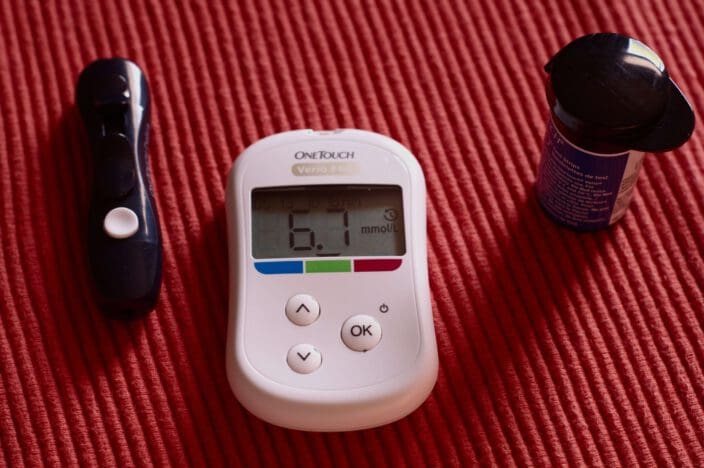Last Updated
The Statistics on Eye Disease in America (2022)
Home / Vision Education /
Last Updated
The Centers for Disease Control and Prevention (CDC) offers prevalence estimates for the most common eye disorders and eye diseases. The most common eye disorders in the United States are refractive errors.
Age-related macular degeneration is a major cause of blindness in adults. The development of large drusen deposits may increase the risk for macular degeneration.
Cataracts are common causes of visual impairment. Diabetic retinopathy can cause visual impairment in people who have diabetes.
Glaucoma is a disease that damages the optic nerve and can lead to visual impairment or blindness. Amblyopia and strabismus are disorders that most commonly occur in children.
The American Academy of Ophthalmology (AAO) offer statistics on the prevalence of visual impairment due to eye disorders by ethnicity as well as the breakdown of people who are legally blind due to eye diseases or eye disorders by ethnic group.
The CDC also offers some interesting figures regarding disorders or diseases of the eye.

Statistics On Common Vision Disorders
In the United States alone, about 12 million people age 40 and above suffer from vision impairment, with about a million suffering from blindness. Globally, the statistics are just as similar, with reports from the World Health Organization showing over 2.2 billion people with eye and vision problems.
Table of Contents
Generally, there are numerous eye conditions that affect people, and different risk factors can increase your chances of developing certain vision disorders. However, reading from the Center for Disease Control and Prevention (CDC), some eye problems are more common than others.
For example, in the United States, common eye disorders include refractive errors, glaucoma, age-related macular degeneration, diabetic retinopathy, and cataracts. Just how common are these conditions, and how has COVID-19 affected vision health and treatment? Let’s have a look at some of these statistics below.
Data Provided by the Centers for Disease Control and Prevention
The Centers for Disease Control and Prevention (CDC) reports that the most common eye diseases and eye disorders include refractive errors, age-related macular degeneration, cataracts, diabetic retinopathy and glaucoma. The CDC reports the generalized prevalence rates of these disorders.
Refractive Errors
Refractive errors include eye disorders, such as astigmatism (disordered vision at any distance), hyperopia (farsightedness), and myopia (nearsightedness). Refractive errors also include presbyopia, the inability to focus on things up close, such as reading small print.
Refractive errors of the eye are the most common causes of visual disturbances in the United States. A breakdown looks like this:
- Astigmatism occurs in about one out of every three people in the United States.
- Farsightedness occurs in about 8.4 percent of the population over the age of 40 (over 14.2 million people).
- Nearsightedness occurs in about 23.9 percent of the population over 40 years old (about 34 million people).

The CDC suggests that corrective lenses can improve vision for people with these disorders in almost every case. In some cases, surgery may be required, but corrective lenses are the standard treatment approach for these disorders.
Some of the conditions categorized under refractive errors include myopia, hyperopia, astigmatism and presbyopia. Refractive errors constitute the majority of causes leading to vision complications. For example, astigmatism develops in one of every four people, hyperopia affects over 14 million people, and myopia develops in 34 million people across the United States.
Surgery and corrective lenses can be used to manage and treat most refractive errors.
Age-Related Macular Degeneration
Macular degeneration or age-related macular degeneration (AMD) is a disorder of the eye that is often associated with aging. It leads to impairments in central vision and sharp vision.
AMD affects the central part of the retina, known as the macula, that allows the eye to discriminate fine details in the center of the visual field. AMD is the leading cause of visual impairment and reading problems in people over the age of 60.
There are two different types of AMD.
- Wet AMD is a result of abnormal blood vessels behind the retina leaking blood and other fluid. The scarring of the vessels can lead to damage in the retina. One typical early symptom of wet AMD is that straight lines or edges appear curved or wavy.
- Dry AMD occurs from the macula deteriorating due to age and blurring central vision. This accounts for 70 to 90 percent of AMD cases. Central vision is generally lost in the affected eye.
The CDC reports that more than 1.8 million Americans over the age of 40 are affected by AMD. Projections are that almost 3 million people will be affected by AMD by 2020.
Drusen Deposits
An additional 7.3 million people are affected by vision problems associated with large drusen deposits — white or yellow deposits that form under the retina. Drusen is made up of fatty proteins called lipids.
Small drusen deposits do not appear to affect vision, but large drusen deposits may be associated with an increased risk for the development of AMD.
Cataracts
Cataracts refer to a clouding of the lens of the eye. Cataracts are the leading cause of blindness across the world. They can occur due to a variety of causes, and they can even be present at birth.
Treatment for cataracts, including surgical removal of cataracts, is readily available in the United States. Barriers, such as a lack of awareness or problems with insurance coverage, may keep people from getting the treatment they need.
The CDC reports that 17.2 percent of Americans over 40 years of age have a cataract in at least one eye (about 20.5 million people). By 2028, it is expected that over 30 million people will have cataracts.
Surgery is the most recommended treatment option for dealing with cataracts. Only about 6.1 million Americans have had their lenses surgically removed and replaced with new lenses to address their cataracts, according to the CDC.

Diabetic Retinopathy
Diabetic retinopathy is a progressive disease that damages blood vessels in the retina and is caused by diabetes. The condition progresses from mild blockage, but if left untreated, it can lead to blindness.
The damage typically progresses through four stages, beginning with mild blockage in the retinal vessels and moving to advanced blockage. Diabetic retinopathy typically affects both eyes in people who have it, so visual loss is bilateral.
The CDC estimates that 4.1 million Americans are affected with diabetic retinopathy, and nearly 900,000 Americans are threatened with vision-damaging retinopathy.
Treatment consists of early diagnosis of the disease and treatment for diabetes. The CDC reports that perhaps 50 percent of patients with diabetes are not getting their eyes examined and are not diagnosed early enough for the treatment to be effective.
Glaucoma
Glaucoma is a progressive condition that gradually breaks down the optic nerves and can lead to vision loss. The Glaucoma Research Foundation details that about 3 million people suffer from the condition, although most don’t know it.
Medical experts know of no cure for glaucoma, although surgery and medication can be used to slow down the disease’s progression rate.
Amblyopia and Strabismus
Amblyopia, or lazy eye, develops when there are poor connections between the eye and brain, commonly affecting children. In fact, it is the most common cause of childhood vision issues.
Strabismus, or cross-eyes, occurs when there are refractory problems in one or both eyes. These conditions have an occurrence rate of about 3 percent in children. It occurs when the visual acuity of one eye is reduced because the connection between that eye and the brain is not working appropriately. The brain then favors use of the other eye.

Strabismus is an imbalance in the positioning of the two eyes or a refractory problem that is different in both eyes. It can lead to cross-eyed conditions in children.
According to a research study reported in the journal Ophthalmology in 2009, the prevalence of amblyopia was under 2 percent in Caucasian and African American in a sample of over 3,000 children. The prevalence of strabismus was 3.3 percent in Caucasian children and 2.3 percent in African American children.
Breakdown of Eye Disorders and Diseases by Ethnicity
The American Academy of Ophthalmology (AAO) offers a breakdown of the visual impairment associated with common eye disorders by ethnicity.
- Cataracts may be responsible for visual impairment in 42.2 percent of non-Hispanic whites, 41.7 percent of African Americans, and 48 percent of Hispanics who suffer from visual impairment.
- Age-related macular degeneration may be responsible for vision loss in 28.1 percent of non-Hispanic whites, 7.8 percent of African Americans, and 14.5 percent of Hispanics who suffer from visual impairment.
- Diabetic retinopathy may be responsible for visual impairment in 4.7 percent of non-Hispanic whites, 12.2 percent of African Americans, and 50 percent of Hispanics who suffer from visual impairment.
- Glaucoma may be responsible for vision impairment in 2.3 percent of non-Hispanic whites, 11.3 percent of African Americans, and 6.4 percent of Hispanics who suffer from visual impairment.
Visual impairment is described as vision less than or equal to 20/40.
Breakdown of Blindness by Ethnicity
AAO outlines the breakdown of legal blindness associated with eye disorders and diseases according to ethnic group.
- Cataracts cause legal blindness in 10.3 percent of non-Hispanic whites, 25 percent of African Americans, and 7.9 percent of Hispanics who are legally blind.
- Age-related macular degeneration is believed to cause of blindness in 46.6 percent of non-Hispanic whites, 4.2 percent of African Americans, and 23.7 percent of Hispanics who are legally blind.
- Diabetic retinopathy is believed to cause blindness in 6.9 percent of non-Hispanic whites, 8.3 percent of African Americans, and 18.4 percent of Hispanics who are legally blind.
- Glaucoma is believed to cause blindness in 5.2 percent of non-Hispanic whites, 18.8 percent of African Americans, and 10.5 percent of Hispanics who are legally blind.
Legal blindness is defined as best corrected vision that is less than or equal to 20/200.
How COVID-19 Affected Eye Health and Eye Surgeries
One of the direct results of the COVID-19 pandemic is the restriction of movement and the reliance on digital technology not only to communicate with friends and family via Facetime and Zoom but also to conduct work. Many companies were pushed to create a remote workforce, and it has caught on.
These personal and employment changes made almost everyone increase their screen time on any number of digital devices (cell phone, tablet, laptop, etc.). Increased screen time can cause strain to your eyes and lead to vision problems.
COVID-19 also impacted vision surgeries and other office-related treatment options. Some were not available for months. And some options were gone altogether if an eye practice was forced to go out of business because of the pandemic.
This, too, means more people have had to endure poor eyesight and vision complications.
Other Figures
The following are other relevant figures listed by the CDC and AAO:
- About 1.3 million Americans over the age of 40 are legally blind.
- About 4.2 Americans over the age of 40 are visually impaired.
- More than 150 million Americans use corrective lenses for refractive errors.
- About 37 million Americans use contact lenses.
- It is estimated that about 1 million Americans develop eye infections each year, with the majority of these being related to the use of contact lenses.
References
- Common Eye Disorders. (April 2015). Centers for Disease Control and Prevention.
- What Are Drusen? (May 2019). American Academy of Ophthalmology.
- Glaucoma Facts and Stats. (October 2017). Glaucoma Research Foundation.
- Prevalence of Amblyopia and Strabismus in White and African American Children Aged 6 through 71 Months: The Baltimore Pediatric Eye Disease Study. (November 2009). Ophthalmology.
- US Eye Disease Statistics. (2019). American Academy of Ophthalmology.
- Vision Health Initiative. (June 2020). Centers for Disease Control and Prevention.
- Blindness and Vision Impairment. (October 2021). World Health Organization.
- Four in 10 U.S. Adults Are at High Risk for Vision Loss. (March 2020). National Eye Institute.
- Glaucoma Facts and Stats. (October 2017). Glaucoma Research Foundation.
- Recreational Screen Time Behaviors during the COVID-19 Pandemic in the U.S.: A Mixed-Methods Study among a Diverse Population-Based Sample of Emerging Adults. (May 2021). National Center for Biotechnology Information.
The information provided on this page should not be used in place of information provided by a doctor or specialist. To learn more, read our Privacy Policy and Editorial Policy pages.